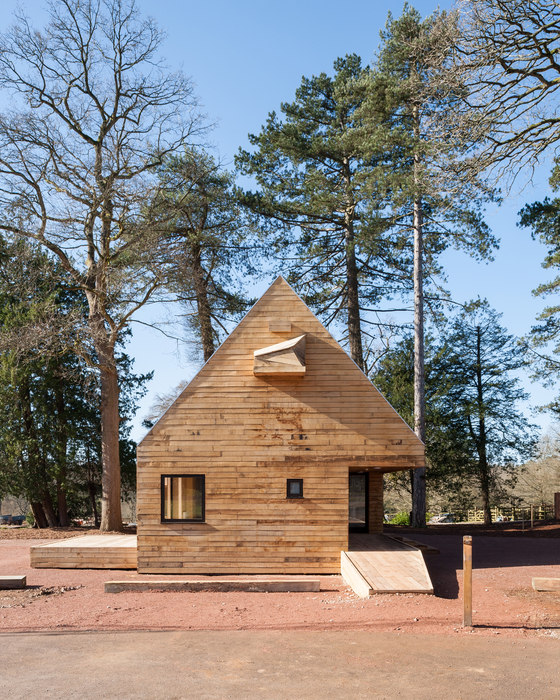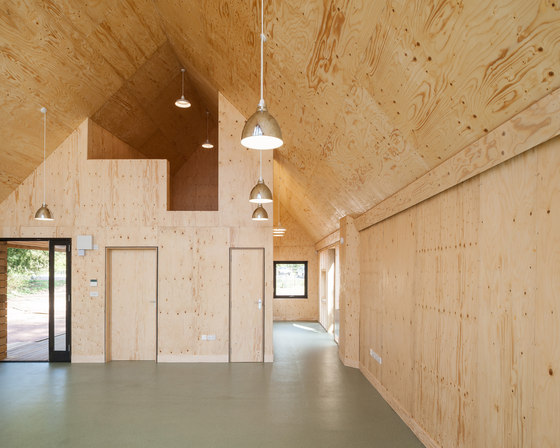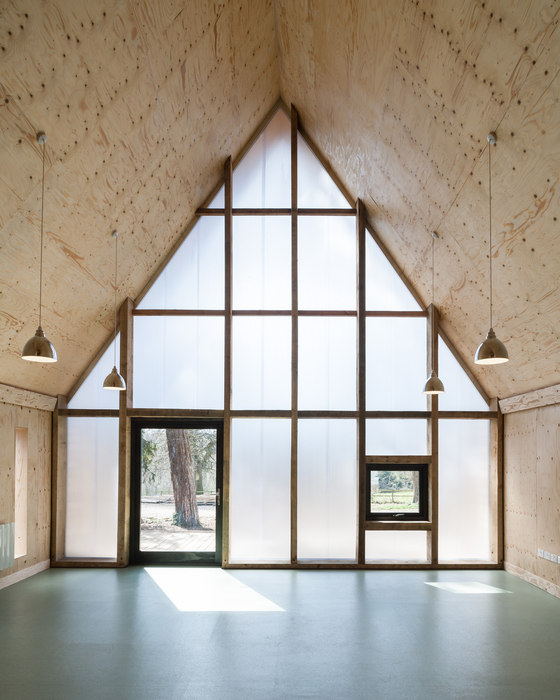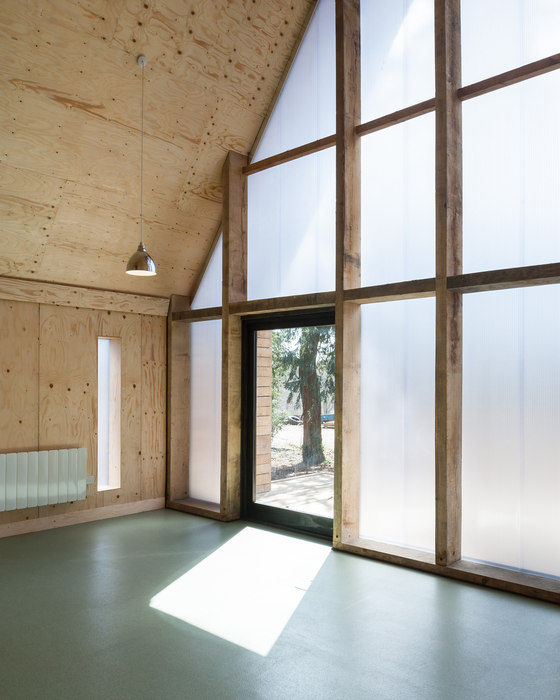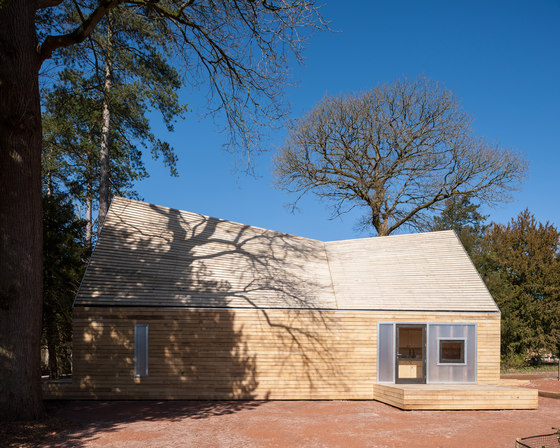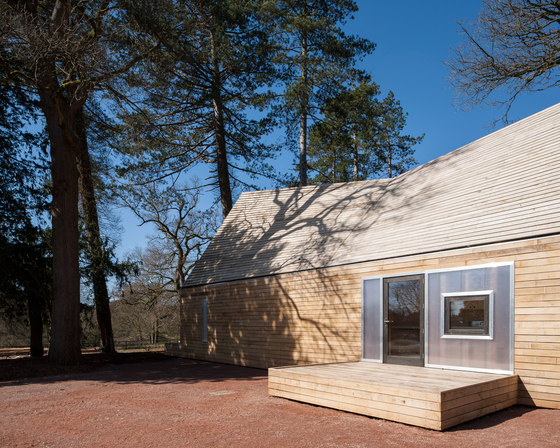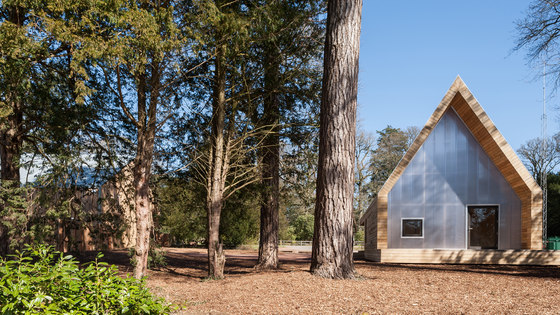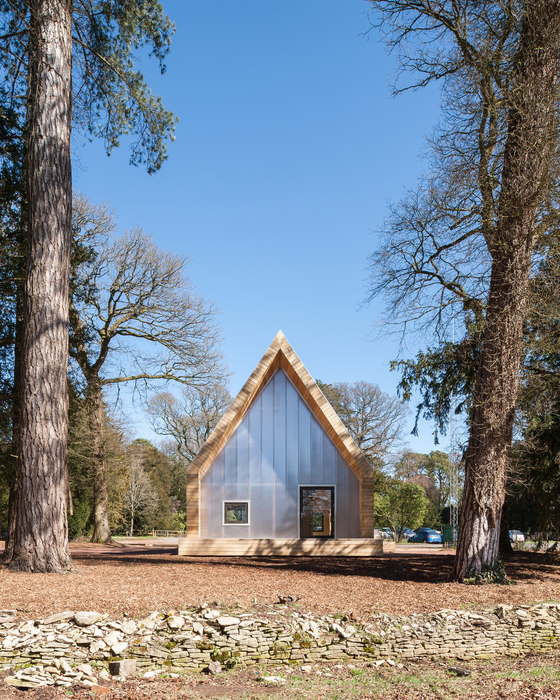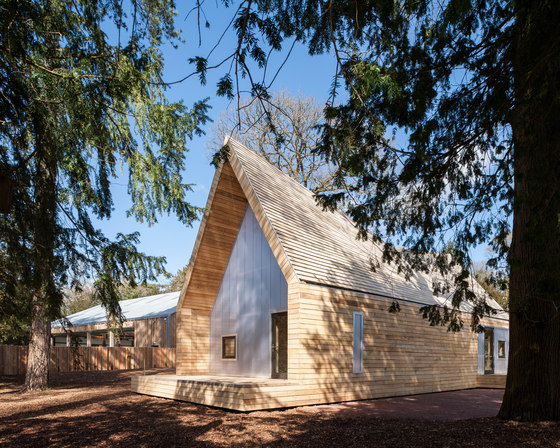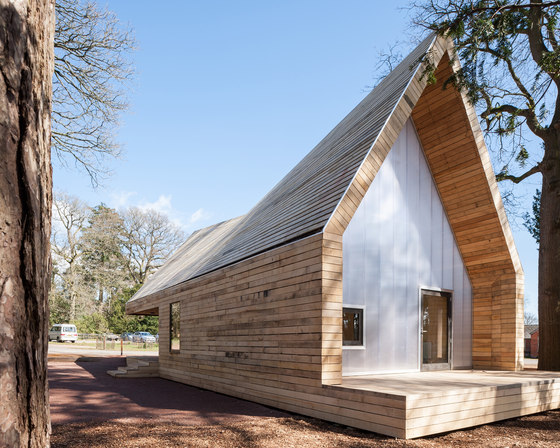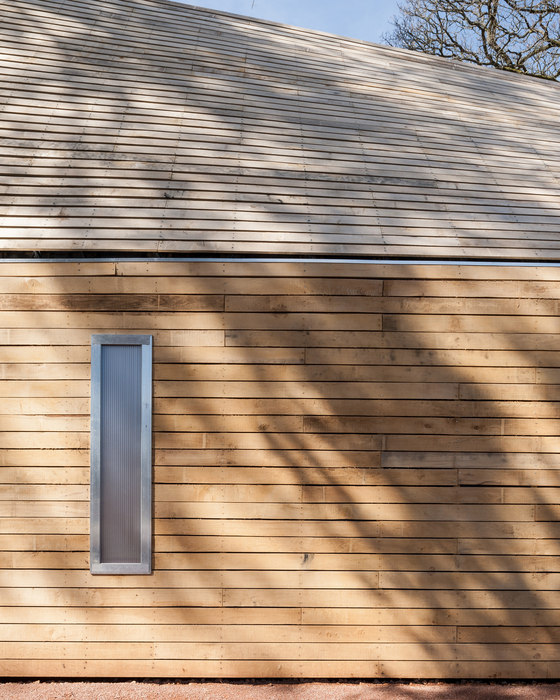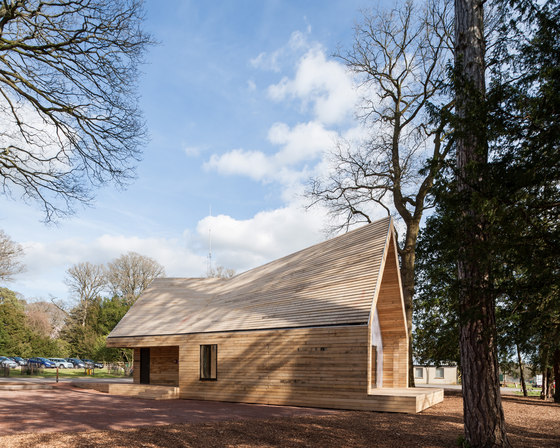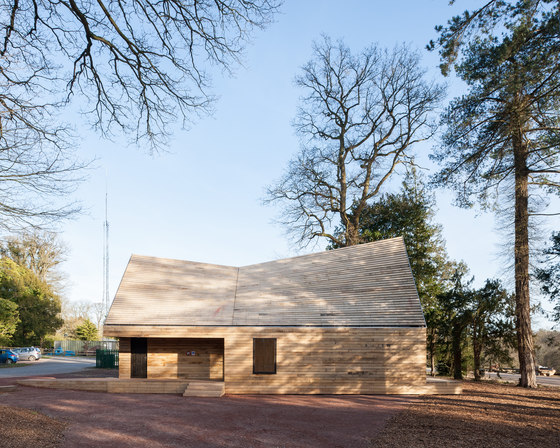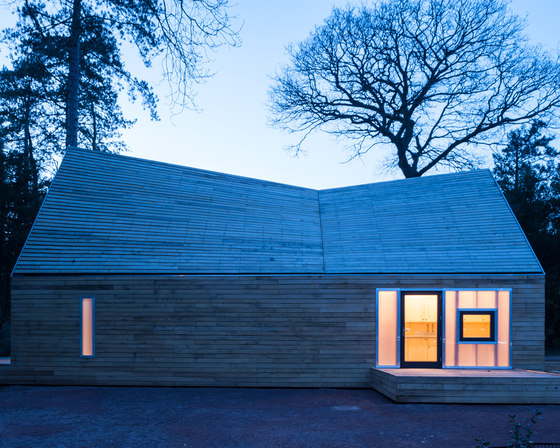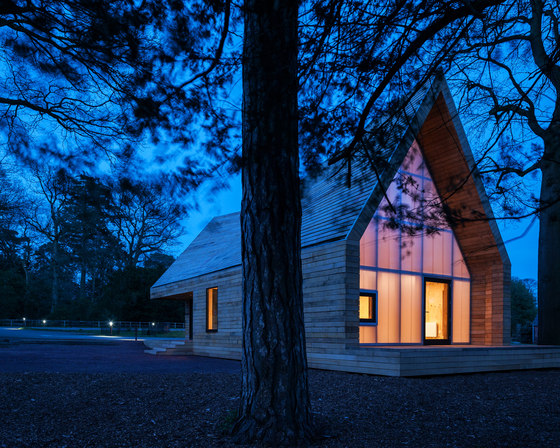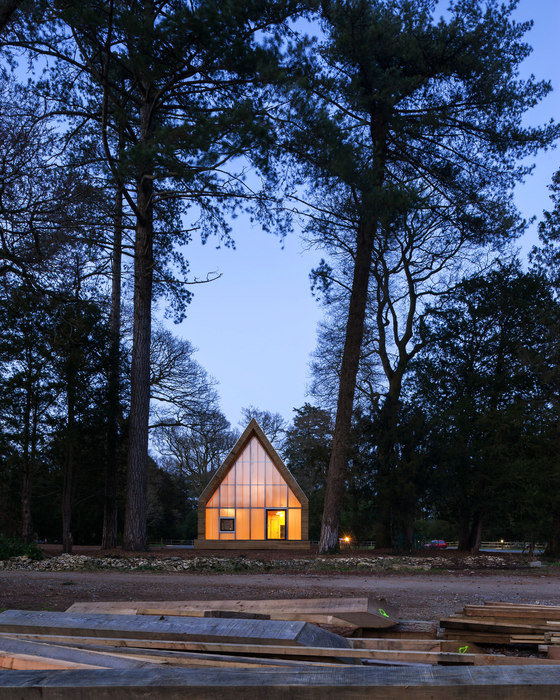Architect and Engineer Statement:
Invisible Studio were commissioned to build 2 new buildings comprising their new tree management centre – which is a Machinery Store and a Welfare Facility for the Tree Team. We particularly wanted to use the timber from the arboretum – as the client had an extraordinary resource which they hadn’t exploited previously for building. As a result, all the timber was grown and milled on site, and used untreated for the construction with no further processing.
One of our interests is how you can use imprecise materials to make a precise building, and this is something we have enjoyed with this project, which was constructed with volunteers working alongside a skilled contractor.
The engineering objective for the design for the building was to efficiently use timber from the arboretum; with all processing taking place on site minimising transport and processing costs. Many of the timbers to be used for the structures had not been felled until late in the design process and the design was adapted to suit the material that became available. A dialogue between engineers, architect and the contractor during fabrication of the timber frames facilitated the use higher quality timber where strength was most critical and in other areas make use of timbers that had not achieved the higher strength grading. This approach allowed the team to efficiently use the materials available.
Text by LAURA MARK for Architects’ Journal giving summary of building:
Two new buildings – a big-span machinery store and staff facilities – have been created at the National Arboretum, using timber grown on the estate to create robust, well-designed simple buildings, says Laura Mark
Westonbirt Arboretum is a 2.4km² estate, established in the 1850s by wealthy landowner Robert Holford. Now owned by the Forestry Commission, the Grade I-listed landscape, which houses an internationally recognised collection of trees, has been the subject of a £4.3 million programme to regenerate the visitor attraction.
The first phase of the arboretum’s masterplan was mainly focused on visitors and included a new welcome centre by Glenn Howells Architects. Clad in Douglas Fir and Western Red Cedar, the curved timber-framed building completed in 2014.
Invisible Studio’s two new additions to the estate are more private. Located at the far end of the arboretum site, they are staff-focused and have their needs at the heart of the design. Previous staff facilities were poor, with equipment located in numerous places across the site; the tree team would often waste hours each day collecting vehicles and machinery. The two new buildings will change this, providing everything in one place.
The first – a tiny mess room – provides space for staff and volunteers to eat and take time out while also including storage and facilities to maintain kit. The second space is a vast timber-framed shed built to house the machinery needed to maintain the estate’s 15,000 trees. Despite having an abundance of trees on its site, Westonbirt’s buildings have rarely been built using them. But in these two buildings Invisible Studio has turned that around.
In this respect the machinery building is probably the most exciting. To create its large column-free open-plan space, huge Corsican pines, around 140 years old, were felled. These were then milled, graded and hand-hewn on site to provide the 20m-long beams needed for the building’s king post trusses.
The mess building, though of a different scale, also benefited from the timber readily available on the woodland site. It has been clad in oak, felled as part of the arboretum’s tree management of its Silk Wood coppice.
This little cabin-like building has an almost fairy-tale quality. Its location was determined by the surrounding trees beneath which it nestles, while its hyperbolic paraboloid roof has been shaped by the winter sun; it was designed so that during the winter months it would allow daylight into the yard behind. Inside it is simple with just two rooms and a loft storage space, all lined in plywood.
The project is a clear progression of Invisible Studio founder Piers Taylor’s work on the Architectural Association’s Design and Make programme at Hooke Park, which he helped to found. The mess building echoes Hooke Park’s Caretaker’s House. Many of the same details are employed: the copper taps, plywood interior, covered entrance and timber cladding.
The scheme also features polycarbonate cladding similar to that which Taylor used on the Big Shed at Hooke Park. On the mess building this forms the scheme’s end wall, letting diffuse light flood into the main space, while on the larger shed-like building it is also used to bring in light and break up the large elevation.
Perhaps what Taylor has learned most from his other projects is how to handle a building that is being constructed by relatively unskilled labour. On the mess building, battens were bought in rather than being milled on site. This allowed them to be used as a setting out for the rest of the building, enabling other elements, such as the cladding, to be more ad hoc. ‘You can’t be precious about detailing when it is being built by volunteers,’ says Taylor. Many of the details were worked out on site and adjusted depending on the natural properties of the timber and the construction work happening around the site.
Using local materials as well as volunteers, many of whom had been working at the arboretum for a number of years, has given the buildings a real sense of being borne out of the surrounding landscape. Those who helped to build them also feel empowered and have picked up new carpentry skills. One volunteer told me he planned to use what he had learned working on the mess building to eventually help him build his own home.
The project has clearly benefited from Taylor’s maverick approach. The scheme – one of the largest since his unexpected split from the studio he co-founded, Mitchell Taylor Workshop – feels like it is the kind of work Taylor really wants to do; a piece that was made possible by the collaborative nature of his reincarnation as Invisible Studio. This studio format allowed Taylor to team up with long-term collaborator and timber expert Charley Brentnall, who he also worked with at Hooke Park. Brentnall worked with Taylor as Invisible Studio on the initial design, and was later appointed as contractor for the machinery building. Brentnall’s knowledge of working with timber and unskilled labour has also helped to shape this scheme.
Westonbirt has got a pair of buildings that really harness the natural properties of timber and use it to deliver good quality, robust, well-designed simple buildings. They do not pretend to be something they are not.
Soon the arboretum will see the completion of a 300m-long meandering treetop walkway, also designed by Glenn Howells Architects. Made using steel and imported timber, it is in stark contrast to Taylor’s modest additions. But like rebel Taylor and his non-conformist studio, the buildings give a cheeky nod to their more conservative and elaborate neighbours.
Client’s view
After completing phase one of the Westonbirt Project, which focused on visitor-orientated improvements, including a new Welcome Building, we prioritised the tree team’s facilities as the next project, alongside the construction of the new STIHL Treetop Walkway.
Looking after our internationally important tree collection is of utmost importance and central to the arboretum’s very existence, so this part of the project aimed to ensure our expert tree team has the facilities it needs to carry out this important work.
The team’s previous facilities were old and poorly laid out, with equipment being kept in numerous locations; often outside at the mercy of the elements. The team estimated that it wasted up to two hours each day manoeuvring vehicles; time that could be better spent caring for the arboretum! The new building addresses this by creating a large open space with room to park all the vehicles under cover.
Our brief to INVISIBLE STUDIO was to create two buildings: one for the team to store and maintain vehicles; and one to provide communal welfare space – both within a tight budget.
We wanted the design to reflect the other buildings here, but to also use our own timber produced as part of our routine management of the tree collection. It was also important to us to involve volunteers and trainee carpenters as much as possible in construction. This involved a number of timber framing courses, staff involvement and more than 179 days of volunteer time in the construction of the mess building!
The buildings go beyond the brief – we are very proud of them and hope they inspire others to use locally sourced timber where possible.
Engineers’ view
The engineering objective for the design of these buildings was to make efficient use of timber from the arboretum, with all processing taking place on site to minimise transport and processing costs. Many of the timbers used for the structures were not felled until late in the design process, and the design was adapted to suit the material that became available. A dialogue between engineers, architect and the contractor during fabrication of the timber frames facilitated the use of higher-quality timber where strength was most critical, while using timbers that had not achieved the higher strength grading in other areas. This approach allowed the team to use the materials available for both the modern design of the smaller mess building and the larger, more traditional, form of the machinery store.
The traditional structural form of the machine store took advantage of the large Corsican pine trees available, which yielded 300x425mm timbers up to 20m in length to form truss ties. The resultant king post truss minimised fabrication and material processing. The machinery store, unlike traditional frames built with king post trusses, has a lightweight roof covering, and this combined with large openings in the elevations results in high wind generated uplift forces on the roof.
The use of green timber requires careful consideration in design, in particular around connections where splits, liable to form as the timber dries, can compromise capacity. In addition, the traditional timber connections we sought to use are designed to work predominantly in one direction, whereas this structure required significant reversals of loads to be resisted because of uplift forces on the roof. To achieve this, many of the connections were a hybrid of traditional forms, reinforced through modern engineering techniques to ensure additional capacity and robustness.
Invisible Studio
Engineer: Buro Happold
